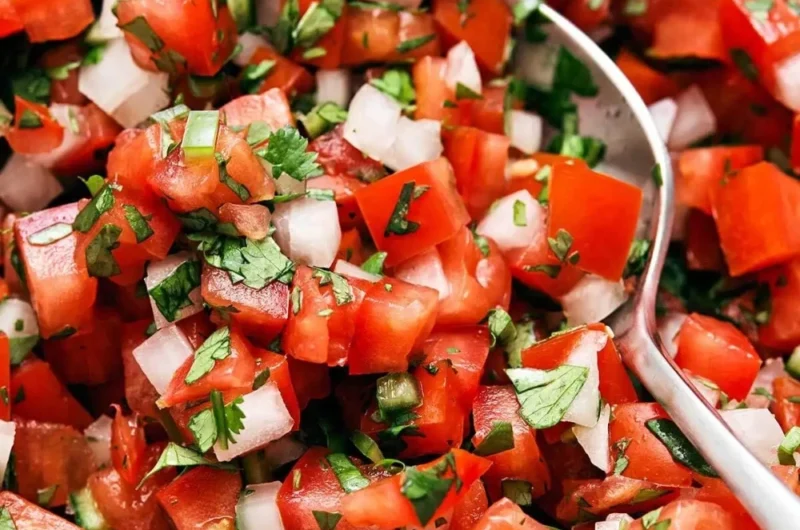The Best Fluffy Pancakes recipe you will fall in love with. Full of tips and tricks to help you make the best pancakes.
The Only Pico de Gallo Recipe You’ll Ever Need (Authentic & Foolproof)

Tired of watery, bland pico de gallo? You’ve come to the right place. This isn’t just a recipe; it’s a guide to mastering the art of salsa fresca, explaining the ‘why’ behind every step. Whether you’re preparing this fresh salsa for a backyard barbecue or elevating your weeknight tacos, this comprehensive guide will transform you from a casual cook into a pico de gallo expert.
What is Pico de Gallo? (Going Deeper)
The “Rooster’s Beak” Myth & Meaning
The name “pico de gallo” literally translates to “rooster’s beak” in Spanish, though the exact origin remains delightfully mysterious. Some food historians suggest it comes from the way people originally ate this fresh salsa—pinching it between thumb and forefinger like a rooster pecking at food. Others believe it refers to the sharp, bright flavors that “peck” at your taste buds. Regardless of its etymology, this traditional Mexican condiment has become a cornerstone of authentic Mexican cuisine.
Pico de Gallo vs. Salsa – The Definitive Comparison
Understanding the difference between pico de gallo and traditional restaurant salsa is crucial for any home cook:
| Feature | Pico de Gallo (Salsa Fresca) | Restaurant-Style Salsa (Salsa Roja) |
|---|---|---|
| Ingredients | Uncooked, Fresh | Often cooked/stewed |
| Texture | Chunky, Hand-chopped | Liquid, Blended |
| Liquid Content | Minimal | High |
| Storage | Best fresh, 1-3 days | Lasts longer |
| Preparation | No cooking required | May involve roasting/cooking |
The Ingredients: A Visual Selection Guide
The secret to exceptional pico de gallo lies in ingredient selection. Here’s your comprehensive guide to choosing the perfect components:
Tomatoes: Why Roma Tomatoes Are Your Best Friend
Roma tomatoes are the gold standard for pico de gallo due to their lower water content and firmer flesh. Look for tomatoes that are:
- Firm but give slightly to gentle pressure
- Deep red color without green shoulders
- Free from soft spots or blemishes
Alternative options: If Roma tomatoes aren’t available, beefsteak tomatoes work well—just remove extra seeds and pulp to prevent excess moisture.
Onions: White Onion vs. Red Onion: A Flavor Showdown
White onions provide the traditional sharp, clean bite that authentic pico de gallo demands. They offer:
- Crisp texture that holds up well
- Sharp, pungent flavor that mellows slightly when mixed
- Classic appearance that matches traditional recipes
Red onions can substitute if you prefer a milder, slightly sweet flavor, but purists stick with white for authenticity.
Cilantro: How to Choose and Chop Cilantro (No Bruising!)
Fresh cilantro should have:
- Bright green leaves without yellowing
- Firm stems that aren’t slimy
- A fresh, herbaceous aroma
Pro tip: Wash cilantro gently, dry completely, and chop with a sharp knife using a rocking motion to prevent bruising.
Jalapeños: Controlling the Heat: The Secret is in the Seeds and Ribs
The heat level in your pico de gallo depends entirely on how you handle the jalapeños:
- Seeds and ribs contain the most capsaicin (heat compound)
- Remove both for mild heat
- Keep seeds for medium heat
- Include ribs and seeds for maximum fire
Look for jalapeños that are firm, glossy, and free from wrinkles.
Limes: The Key to Juiciness: How to Select the Perfect Lime
The best limes for pico de gallo are:
- Heavy for their size (indicating high juice content)
- Bright green with smooth, thin skin
- Slightly soft when gently squeezed
Juice extraction tip: Roll limes on the counter while applying pressure before cutting to maximize juice yield.
Salt: Why Kosher Salt is Non-Negotiable for Flavor and Texture
Kosher salt is essential because:
- Larger crystals distribute more evenly
- No additives that can affect flavor
- Easier to control the amount you’re adding
- Draws out moisture effectively during the maceration process
Step-by-Step Instructions
Ingredients (Serves 6-8):
- 4 large Roma tomatoes, diced (about 2 cups)
- 1 medium white onion, finely diced (about 1 cup)
- 2-3 jalapeño peppers, seeded and minced
- ½ cup fresh cilantro, chopped
- 2-3 fresh limes, juiced (about ¼ cup)
- 1 teaspoon kosher salt, or to taste
Instructions:
- Prepare the tomatoes: Remove the core and dice tomatoes into ¼-inch pieces. Place in a fine-mesh strainer, sprinkle with ½ teaspoon salt, and let drain for 15 minutes.
- Dice the onion: Cut onion into uniform ¼-inch pieces. Consistent sizing ensures even flavor distribution in every bite.
- Prep the jalapeños: Remove stems, slice lengthwise, and scrape out seeds and ribs with a spoon. Mince finely.
- Chop the cilantro: Remove thick stems and roughly chop leaves. Don’t over-chop—you want visible pieces.
- Combine and season: In a medium bowl, combine drained tomatoes, onion, jalapeños, and cilantro. Add lime juice and remaining salt.
- Let it macerate: Allow the mixture to sit for 15-30 minutes before serving. This crucial step lets flavors meld and develop.
The Secret to Restaurant-Quality Pico de Gallo (Expert Tips)
The Maceration Magic
This is where the salt draws out the juices and melds the flavors. During this resting period, the salt breaks down cell walls in the vegetables, creating natural juices that become the base for your salsa’s flavor. Do not skip this step—it’s the difference between good and exceptional pico de gallo.
The Watery Pico Problem Solved
The ultimate technique for preventing watery pico de gallo:
- Salt and drain diced tomatoes separately before mixing
- Use a fine-mesh strainer for 15 minutes
- Gently press tomatoes with paper towels to remove excess moisture
- This single step eliminates the soggy salsa syndrome
The Perfect Dice
Maintain a uniform ¼-inch dice for all ingredients. This ensures:
- Even flavor distribution in each bite
- Professional appearance
- Proper texture balance
- Ingredients don’t overpower each other

Beyond the Classic: Variations & Customizations
For the Fruit Lover:
- Mango Pico: Add 1 cup diced ripe mango for tropical sweetness
- Pineapple Pico: Include ¾ cup diced fresh pineapple for tangy brightness
For the Heat Seeker:
- Serrano Pico: Replace jalapeños with 1-2 serrano peppers for intense heat
- Habanero Pico: Use ¼ of a habanero pepper for volcanic fire
For a Smoky Twist:
- Chipotle Pico: Add 1 minced chipotle pepper in adobo sauce for smoky heat
The “No Cilantro” Version:
Replace cilantro with:
- 2 tablespoons fresh parsley
- Pinch of dried oregano
- This combination provides fresh herbaceous notes without cilantro’s polarizing flavor
The Creamy Edition:
- Avocado Pico: Gently fold in 1 diced ripe avocado just before serving
Serving, Storing, and Pairing Guide
Storage Guidelines:
- Best on Day 1: Peak flavor and texture
- Good for up to 3 days: Store covered in refrigerator
- Drain excess liquid before serving leftover pico
Can You Freeze It?
We don’t recommend freezing pico de gallo. The high water content in tomatoes and onions creates ice crystals that break down cell walls, resulting in mushy texture when thawed. Fresh is always best for this salsa fresca.
Perfect Pairings (Beyond the Obvious):
While pico de gallo shines with tortilla chips and tacos, consider these elevated pairings:
- Grilled chicken or fish as a fresh salsa topping
- Scrambled eggs for a Mexican-inspired breakfast
- Baked sweet potatoes for a healthy, flavorful meal
- Quinoa bowls as a fresh, nutritious addition
- Avocado toast for an Instagram-worthy brunch
The Ultimate Pico de Gallo FAQ
How long does homemade pico de gallo last?
Fresh pico de gallo maintains optimal flavor for 24 hours and remains good for up to 3 days when stored properly in the refrigerator.
Can I make pico de gallo ahead of time?
Yes, but add lime juice just before serving to prevent the acid from breaking down the vegetables prematurely. Prepare other ingredients up to 4 hours in advance.
Why is my pico de gallo watery?
Excess moisture comes from not properly draining tomatoes or using tomatoes with high water content. Always salt and drain tomatoes before mixing.
What’s the best tomato for pico de gallo?
Roma tomatoes are ideal due to their low water content and firm flesh. They maintain structure and don’t make the salsa watery.
Can I use dried cilantro instead of fresh?
Fresh cilantro is essential for authentic flavor and texture. Dried cilantro lacks the bright, herbaceous quality that makes pico de gallo special.
How do I reduce the heat in pico de gallo?
Remove all seeds and ribs from jalapeños, use fewer peppers, or substitute with milder varieties like poblano peppers.
Is pico de gallo healthy?
Absolutely! This fresh salsa is low in calories, high in vitamins C and K, contains antioxidants from tomatoes, and provides healthy compounds from onions and cilantro.
Ready to become a pico de gallo master? This recipe combines traditional techniques with modern insights to create the perfect fresh salsa every time. Remember, the key to exceptional pico de gallo lies in quality ingredients, proper preparation, and patience during the maceration process. Your taste buds—and your dinner guests—will thank you for the extra effort.
The Only Pico de Gallo Recipe You’ll Ever Need (Authentic & Foolproof)
Course: Delicious SaladsCuisine: Mexican12
servings10
minutes15
minutes97
kcalIngredients
From the Cookie and Kate version:
Finely chopped white onion
Finely chopped jalapeño (seeds optionally removed)
Lime juice
Fine sea salt
Ripe red tomatoes (seeded and chopped)
Finely chopped fresh cilantro
Directions
- Combine chopped onion, jalapeño, lime juice, and salt in a bowl. Let sit for 5 minutes.
- Seed and chop tomatoes; finely chop cilantro.
- Add tomatoes and cilantro to the onion mixture and stir well.
- Let rest for 15 minutes or refrigerate for up to a few hours to blend flavors.
- Serve with a slotted spoon to avoid excess liquid.
- Store in the refrigerator for up to 4 days.

